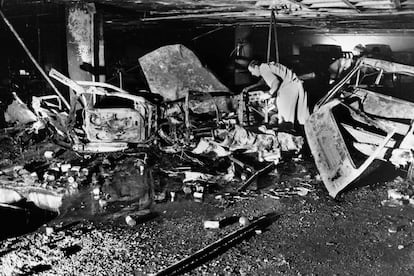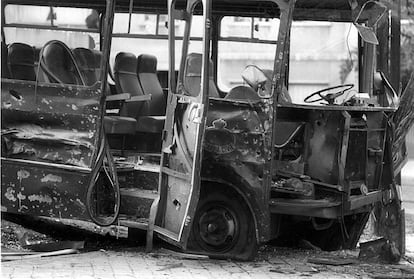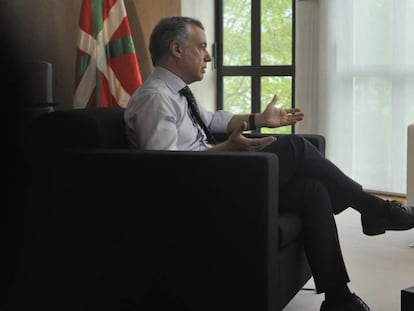The enduring pain of ETA’s victims: struck by terrorism, ignored by society
While the Basque terrorist group may officially be disbanding, those affected by its campaign of violence say there is still a lot left to do before wounds can really heal


Francesc Manzanares still gets emotional when he hears talk of ETA and its dissolution. On June 19, 1987 his sister Mercè, then 30, had taken their other sister Nuria’s children out to buy some bathing suits. All three perished in the bomb attack perpetrated by ETA against the Hipercor superstore in Barcelona. The kids, Silvia and Jordi, were 12 and nine. They joined the list of more than 300 civilians who ETA killed in its 50-year history.
Three decades later, Francesc still cries when he talks about the children and the never-ending suffering of their parents. “I think it’s fine to heal wounds,” he says. “But there is still a lot to be done. The victims’ problems are still there.”
When you suffered an attack, you didn’t exist as far as Spanish society was concerned
Javier López, ex-Civil Guard officer
Javier López, a member of the Civil Guard, saw his life break apart at just 21 years of age. It was 1978 and he was stationed in Basauri, in the Basque province of Vizcaya. As a Civil Guard officer, he was living in nearby barracks with his wife and newborn child.
The barracks were attacked by an ETA cell, who shot him three times. One bullet ended up in his liver, another in a kidney, and a third in his backbone. He spent two years in a wheelchair and had to quit his job. López is one of thousands of law enforcement officers who were wounded by ETA. He believes that the group’s disbandment “does not change a thing.”
“It’s a farce, an image cleanup operation for a group that has already been defeated by the police, by the courts and by society,” he says. “I don’t see any difference with the situation two weeks ago. If there’s any victim who feels safer knowing that ETA won’t strike again, that’s a positive thing. But they are not turning in their weapons and they will not cooperate with the justice system to resolve the more than 300 crimes that they committed with impunity.”

Montxo Doral was a member of the Basque regional police force, the Ertzaintza. He was a pro-independence Basque, and so was his wife Cristina Sagarzazu. And she continued to be pro-independence even after ETA killed her husband on March 4, 1996. “I was not prepared to let those people change my ideals,” she says, 22 years after becoming a widow with three children to raise by herself.
“But my ideas are not compatible with violence,” adds Sagarzazu, who is now 62. “My struggle is not their struggle. I still have to chew on ETA’s dissolution announcement. It’s good that they’re making it clear, but they have caused a lot of suffering, and for nothing. Fortunately, I think that by now nobody believes them anymore, and society knows that it was all for nothing.”
Fernando Garrido, 59, lives in Jaca (Huesca) and does not pay too much attention to the news about ETA’s demise. On October 25, 1986, the terrorist group used a car bomb to assassinate his father Rafael Garrido, who was the military governor of Gipuzkoa province, as well as his mother Daniela Velasco and his 21-year-old brother Daniel.
“To me, the most important moment was when ETA stopped killing,” he notes. “That changed everything, it changed the country and the social harmony. As for its dissolution... it’s just another step. I think a lot about my parents and brothers, but I don’t want to be constantly reading things about ETA.”
All I want is for this never to happen again, for us to take the ghosts to our graves, for the new generations to be saddled with none of it
Alfonso Sánchez Rodrigo, survivor
These are just a few testimonies from victims whose lives were either cut short or badly affected by ETA’s bloody actions throughout its 50-year existence. Official figures show that 854 people were murdered (including the French police officer Jean-Serge Nérin, in March 2010) while thousands more were injured or lived under constant threats.
Around 500 of the individuals killed by ETA were members of the armed forces and law enforcement agencies. The rest were politicians, journalists, judges, entrepreneurs, and people who simply happened to be in the wrong place at the wrong time.
The tally includes assassinations by a smaller group called Autonomous Anti-Capitalist Commandos, whom the government considers to have been within ETA’s circle.
The statistics also show the strategic shifts in ETA’s killing patterns. Before Franco’s death, between 1968 and 1975, ETA killed 44 people, representing 5% of the total. Then came two years with similar death rates (18 and 12). Then, in 1978, the year that Spain approved its new Constitution enshrining democracy, there was a huge spike in ETA killings: 65. The upward trend continued: 77 in 1979 and 95 in 1980.
Loneliness
Those were also years when the victims of terrorism felt very much alone. One of the founders of the Association of Victims of Terrorism (AVT), Ana María Vidal Abarca, who has since passed away, spoke with this newspaper in 2011 about the difficulties of even holding a funeral for the victims. And not just in the Basque Country.

Her husband, a police officer in the southern Basque province of Álava, was murdered on January 10, 1980. “Nobody paid the slightest attention to us,” she recalled. “Together with Sonsoles Álvarez de Toledo and Isabel O’Shea, I founded the association so that the victims would not feel so alone. There were very young women with little children who were forced to move out of the Basque Country, to remote villages across Spain, and they practically had to conceal the fact that they were victims of terrorism.”
Javier López, the former Civil Guard officer who was shot in the back, and who is now the vice-president of the victim association for law enforcement agencies, has the exact same memories.
“In the Basque Country we were alone and ostracized. Our families had to lie about our jobs. Our wives were afraid that people would notice their accent at stores and be forced to explain where we were from. Our children had to say at school that their dad worked for some large company like Telefónica, and that’s why we were living there,” he recalls.
“Later, when you suffered an attack, you didn’t exist either as far as Spanish society was concerned,” he goes on. “Your close circle was with you, but other people turned their backs on terrorism. It was only after the big massacres, like the Hipercor or the Zaragoza barracks, and when ETA started killing politically and socially relevant people, that society began to change. The kidnapping and murder of Miguel Ángel Blanco was a turning point, of course.”

The kidnap and assassination of the 29-year-old Popular Party (PP) town councilor from Ermua, in August 1997, made society openly acknowledge the brutality of terrorism. More victims’ associations were created – nearly every region of Spain has one now – as well as many foundations in memory of some of the dead, such as the politicians Fernando Buesa (a socialist) and Gregorio Ordóñez (a conservative).
In 1999, the Spanish parliament approved the Law of Solidarity with Victims of Terrorism, and in 2011 the Law of Victims of Terrorism went into effect, guaranteeing a degree of state aid that had been considered unthinkable until then. Victims, however, complain about the tremendous bureaucracy surrounding these funds, and note that some of them continue to struggle to get their rights recognized even today.
Alfonso Sánchez Rodrigo, 52, a Civil Guard officer who currently presides the AVT and is a survivor of ETA’s 1985 attack in República Argentina square in Madrid, speaks openly about the fear that he felt back in those days.
In 1988 he was stationed in Eibar, a town in the Basque province of Gipuzkoa. “You slept with your gun near the bed, and gritted your teeth every time you drove through a tunnel, expecting an ambush,” he recalls.
“ETA has caused a lot of pain, it has destroyed entire families. What we are seeing now is the beginning of the end, but there is a lot left to do. There’s still the victims, the forgiveness, the more than 300 unresolved attacks... All I want is for this never to happen again, for us to take the ghosts to our graves, for the new generations to be saddled with none of it.”
The day that he was injured in the Madrid attack, Sánchez Rodrigo recalls that he was lying half naked in a hospital emergency room along with other wounded officers when a kind man showed up to inquire about their state. It was Health Minister Ernest Lluch. Fifteen years later, when he had already retired from politics, Lluch was murdered by ETA.
English version by Susana Urra.
Tu suscripción se está usando en otro dispositivo
¿Quieres añadir otro usuario a tu suscripción?
Si continúas leyendo en este dispositivo, no se podrá leer en el otro.
FlechaTu suscripción se está usando en otro dispositivo y solo puedes acceder a EL PAÍS desde un dispositivo a la vez.
Si quieres compartir tu cuenta, cambia tu suscripción a la modalidad Premium, así podrás añadir otro usuario. Cada uno accederá con su propia cuenta de email, lo que os permitirá personalizar vuestra experiencia en EL PAÍS.
¿Tienes una suscripción de empresa? Accede aquí para contratar más cuentas.
En el caso de no saber quién está usando tu cuenta, te recomendamos cambiar tu contraseña aquí.
Si decides continuar compartiendo tu cuenta, este mensaje se mostrará en tu dispositivo y en el de la otra persona que está usando tu cuenta de forma indefinida, afectando a tu experiencia de lectura. Puedes consultar aquí los términos y condiciones de la suscripción digital.
More information
Archived In
Últimas noticias
The new victims of the Republican war on Obamacare: Millions hit by soaring health insurance premiums
A country divided on migrant rights: Some US states expand protections while others restrict them
Venezuela authorizes the release of another 87 political prisoners
There is as much life left to discover on planet Earth as that which is already known
Most viewed
- David King, chemist: ‘There are scientists studying how to cool the planet; nobody should stop these experiments from happening’
- Reinhard Genzel, Nobel laureate in physics: ‘One-minute videos will never give you the truth’
- Oona Chaplin: ‘I told James Cameron that I was living in a treehouse and starting a permaculture project with a friend’
- Sinaloa Cartel war is taking its toll on Los Chapitos
- The Interoceanic Train, the Mexican alternative to the Panama Canal










































